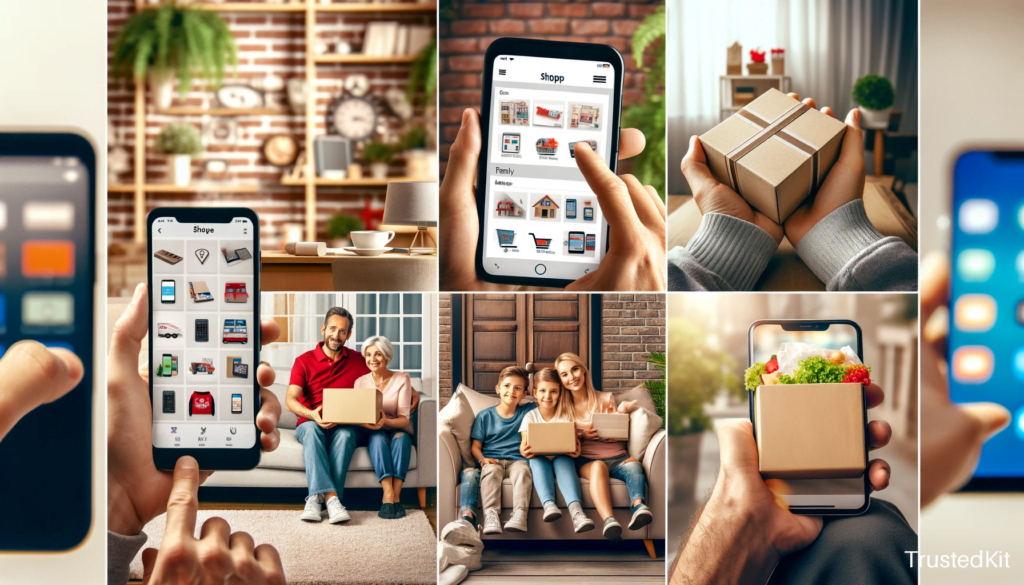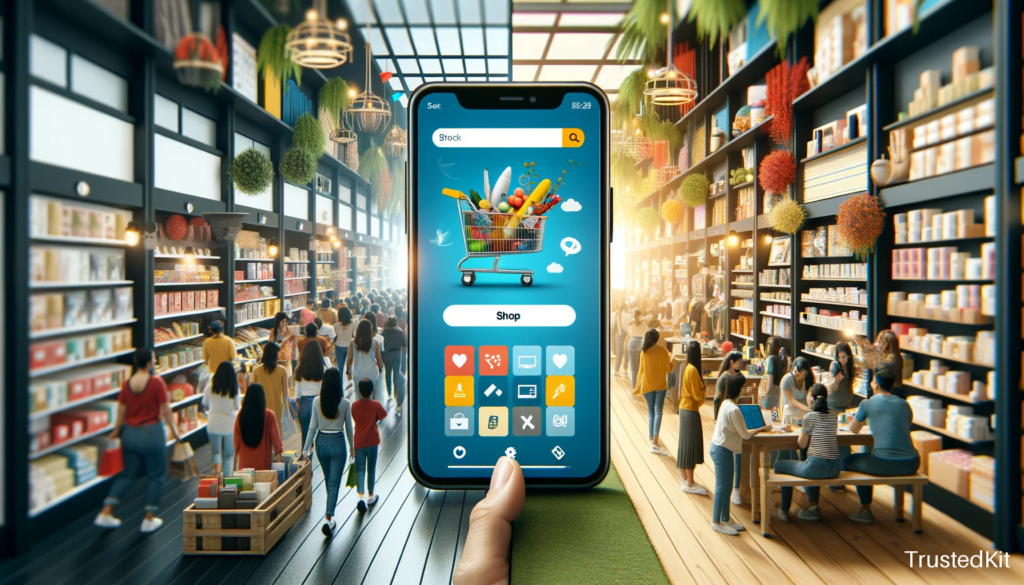TL;DR (Too Long; Didn’t Read)
- Mobile Commerce Importance: Mobile devices are increasingly dominant in online shopping, making mobile optimization essential.
- Responsive Design: Essential for a seamless shopping experience on various devices.
- User-Friendly Navigation and Speed: Improving load times and easy navigation boosts user experience.
- Secure and Streamlined Checkout: Simple, secure payment options reduce cart abandonment.
- Personalization and Engagement: Use data-driven strategies for a personalized shopping experience and leverage mobile marketing.
- Measuring Success: Track KPIs and use customer feedback for continuous improvement.
- Continuous Adaptation: Stay updated with trends and technologies to keep your mobile commerce strategy effective.
In the ever-evolving landscape of digital retail, mobile commerce has emerged as a pivotal aspect of online business success. With the majority of internet users accessing the web via mobile devices, optimizing your e-commerce store for mobile isn’t just an option—it’s a necessity. This comprehensive guide will delve into the essential strategies for enhancing your mobile commerce experience, ensuring your online store is not just surviving, but thriving in the mobile-dominated marketplace.
Table of Contents
Introduction

The shift towards mobile internet usage has significantly altered consumer behavior, making mobile commerce (or m-commerce) an indispensable element of any successful e-commerce strategy. In fact, recent statistics show that mobile commerce is projected to account for nearly 73% of e-commerce sales by 2021. This staggering figure highlights the critical need for online stores to optimize their mobile presence. Our focus in this article is to explore comprehensive strategies for enhancing the mobile commerce experience, ensuring your store is perfectly poised to capture this growing market.
Understanding Mobile Commerce Optimization
What is Mobile Commerce?
Mobile commerce, often referred to as m-commerce, is the buying and selling of goods and services through mobile devices such as smartphones and tablets. It encompasses a wide range of activities, including mobile shopping apps, mobile-responsive websites, mobile payments, and mobile wallets.
The Significance of Mobile Optimization for E-commerce Businesses
Mobile commerce, often abbreviated as m-commerce, refers to the buying and selling of goods and services through wireless handheld devices such as smartphones and tablets. As the world increasingly adopts mobile technology, the importance of optimizing e-commerce operations for mobile devices cannot be overstated.
Mobile optimization means more than just making your site accessible on a smartphone. It’s about creating a seamless, intuitive, and enjoyable shopping experience that’s tailor-made for the mobile user. This approach can significantly enhance customer satisfaction, increase sales, and improve your brand’s reputation.
The Rise of Mobile Commerce
- Trends and Statistics: A report from eMarketer predicted that by 2021, mobile e-commerce sales are expected to account for 54% of total e-commerce sales.
- Consumer Behavior Changes: The convenience of shopping anytime, anywhere, has led to a surge in mobile shopping. Customers now expect a flawless mobile shopping experience, from browsing to checkout.
Assessing Your Current Mobile Commerce Readiness
Understanding your current mobile commerce readiness is crucial. Here’s a quick checklist:
- Mobile Responsiveness: Is your website adaptable to different screen sizes and devices?
- Loading Speed: How quickly do your pages load on mobile devices?
- Ease of Navigation: Can users easily find what they’re looking for on your mobile site?
To evaluate these aspects, tools like Google’s Mobile-Friendly Test can be invaluable. This tool not only analyzes how well your site works on mobile devices but also provides suggestions for improvement.
Mobile Website vs. Mobile App
Deciding between a mobile website and a mobile app is crucial for your strategy. Here are some considerations:
- Mobile Website: Accessible via a browser and does not require downloading. It’s generally cheaper and easier to maintain.
- Mobile App: Offers a more personalized experience and can utilize device features like cameras and GPS. However, it requires users to download the app.
Both have their pros and cons, and the choice largely depends on your business needs and customer preferences.
Benefits of Mobile Commerce Optimization
Improved User Experience
Mobile commerce optimization focuses on creating a seamless and user-friendly experience for customers on mobile devices. A responsive design ensures that your website adapts to various screen sizes and orientations. This adaptability eliminates the need for excessive zooming or horizontal scrolling, enhancing user satisfaction.
Increased Conversion Rates and Sales
A mobile-optimized website is more likely to convert visitors into customers. When users can easily navigate your site, view products, and complete purchases on their mobile devices, conversion rates tend to rise. According to a report by Adobe, companies with mobile-optimized sites saw a 12% increase in year-over-year revenue.
Competitive Advantage
In the fiercely competitive e-commerce landscape, having a mobile-optimized store sets you apart from competitors who neglect mobile users. It demonstrates your commitment to providing the best shopping experience across all devices, giving you a competitive edge.
Enhanced SEO Rankings
Google’s mobile-first indexing means that the search engine primarily uses the mobile version of a site for ranking and indexing. A mobile-optimized website is more likely to achieve higher search rankings, leading to increased organic traffic.
Key Strategies for Enhancing Mobile Commerce Experience

Optimizing your store for mobile commerce involves several key strategies, each contributing to a more effective and engaging user experience.
Responsive Website Design
What Is Responsive Web Design?
Responsive web design is an approach that ensures a website’s layout and content adapt to various screen sizes and devices. It utilizes flexible grids, layouts, and media queries to provide a consistent user experience.
Advantages of Responsive Design
- Consistency: A responsive design maintains the same look and feel across devices, reinforcing your brand identity.
- Improved SEO: Google recommends responsive design as the industry best practice for mobile optimization.
- User-Friendly: Users can easily navigate, read, and interact with content on any device.
Best Practices for Implementing Responsive Web Design
- Use a mobile-responsive theme or template for your e-commerce platform.
- Prioritize mobile-friendly fonts and font sizes.
- Optimize images for mobile to reduce load times.
- Test your website on various devices and screen sizes.
Mobile-Friendly Content
Creating Compelling Mobile-Friendly Content
Mobile users have distinct content consumption habits. To engage and convert mobile shoppers, consider the following:
- Conciseness: Mobile users prefer concise product descriptions and easily scannable content.
- Engaging Visuals: High-quality images and videos are crucial for showcasing products effectively.
- Mobile-Friendly Formats: Use formats that load quickly on mobile, such as AMP (Accelerated Mobile Pages) for articles.
Optimizing Images and Multimedia for Mobile Devices
- Compress images to reduce file size and improve loading speed.
- Use responsive images that adapt to different screen sizes.
- Implement lazy loading to load images as users scroll.
Importance of Mobile-Friendly Product Descriptions
Mobile users rely on product descriptions to make informed decisions. Ensure your product descriptions are clear, concise, and mobile-responsive. Use bullet points and headings to break up content for easy reading.
Simplifying Navigation and User Interface
Streamlining Navigation for Mobile Users
Mobile navigation menus should be straightforward and user-friendly. Consider these navigation tips:
- Use a collapsible or “hamburger” menu icon to save screen space.
- Prioritize essential navigation items and reduce clutter.
- Implement intuitive navigation features like breadcrumbs and “back to top” buttons.
Reducing Page Load Times for Mobile Devices
Page load speed is critical for mobile users. Slow-loading pages can lead to high bounce rates and abandoned shopping carts. To optimize page load times:
- Compress images and minimize HTTP requests.
- Leverage browser caching to reduce load times for returning visitors.
- Use a content delivery network (CDN) to distribute content geographically.
Image Optimization
- Best Practices: Use formats like JPEG for photographs and PNG for graphics with fewer colors.
- Tools: Tools like TinyPNG can compress images without significant loss of quality.
Minimizing Redirects and Plugins
- Redirects: Limit the use of redirects as much as possible.
- Plugins: Only use essential plugins, as too many can slow down your site.
Optimized Checkout Process
Simplifying the Checkout Process for Mobile Users
A cumbersome checkout process can lead to cart abandonment. Streamline the mobile checkout process with these strategies:
- Implement guest checkout options, allowing users to purchase without creating an account.
- Minimize form fields and request only essential information.
- Use auto-fill functionality for address and payment details.
The Importance of Trust Badges and Security Assurances
Mobile shoppers need reassurance that their transactions are secure. Display trust badges, SSL certificates, and security assurances prominently during checkout to build trust.
Mobile Payment Options
Exploring Mobile Payment Methods
Mobile commerce introduces various payment options tailored to mobile users:
- Mobile Wallets: Payment apps like Apple Pay, Google Pay, and Samsung Pay allow users to store payment information securely for quick and contactless payments.
- In-App Payments: E-commerce apps often integrate in-app payment options for seamless transactions.
- One-Click Checkout: Simplify the checkout process with one-click or express checkout options.
Integrating Secure and Convenient Payment Options
Security is paramount in mobile payments. Ensure that payment gateways are secure and compliant with industry standards like PCI DSS. Display trust badges and security assurances to instill confidence in customers.
Prioritizing Mobile Security
Security is a paramount concern in mobile commerce. Customers need to trust that their personal and financial information is safe.
SSL Certificates and Secure Payment Gateways
- SSL Certificates: Essential for encrypting data and building trust.
- Secure Payment Gateways: Choose gateways known for their security and reliability.
Let’s move on to the next section of the article.
Enhancing Mobile User Engagement
To keep your mobile audience engaged, it’s crucial to provide a personalized and interactive shopping experience. Here are strategies to increase user engagement on your mobile commerce platform.
Personalization and Mobile Marketing
Personalization is key in mobile commerce. Tailoring the shopping experience to individual preferences can significantly boost customer loyalty and sales.
- Data-Driven Personalization: Use customer data to provide personalized recommendations and offers.
- Location-Based Services: Offer promotions based on the user’s geographic location.
Mobile Marketing Strategies:
- SMS Marketing: Send personalized offers and updates via text messages.
- Email Marketing: Optimize emails for mobile devices and personalize the content.
Push Notifications and Mobile-Only Promotions
Push notifications are a powerful tool for engaging mobile users. They can be used to alert customers about sales, new arrivals, or abandoned carts.
- Timely Notifications: Send notifications at times when users are most likely to engage.
- Personalized Alerts: Tailor notifications based on user behavior and preferences.
Mobile-Only Promotions:
- Offering exclusive deals for mobile users can incentivize app downloads and repeat visits.
- Examples include special discounts, early access to sales, and mobile-only loyalty programs.
Leveraging Social Media for Mobile Commerce
Integrating social media with your mobile commerce strategy can significantly enhance user engagement.
- Social Sharing: Enable easy sharing of products on social media platforms.
- Shoppable Posts: Utilize features like Instagram’s shoppable posts to directly link products.
Mobile SEO Best Practices
Keyword Research for Mobile
How Mobile Keyword Research Differs from Desktop
Mobile users may use different search queries or phrasing compared to desktop users. Conduct mobile-specific keyword research to identify relevant mobile search terms. Tools like Google’s Keyword Planner and SEMrush offer mobile keyword data.
Optimizing Content with Mobile-Focused Keywords
Once you’ve identified mobile-focused keywords, incorporate them naturally into your content. Mobile searchers often use voice search,
so consider including conversational phrases and long-tail keywords.
Page Speed and Mobile SEO
The Impact of Page Load Speed on Mobile SEO
Google prioritizes fast-loading pages, especially for mobile users. Slow websites can lead to higher bounce rates and lower rankings. Google’s PageSpeed Insights tool can help identify and address speed issues.
Techniques for Reducing Mobile Page Load Times
- Compress images and use responsive design techniques.
- Minimize server response times and leverage browser caching.
- Enable AMP (Accelerated Mobile Pages) for faster loading of articles and blog posts.
Mobile-Friendly Design and SEO
Mobile-First Indexing by Search Engines
Google primarily uses the mobile version of a website for indexing and ranking. Ensure that your mobile site is well-optimized to maintain or improve SEO rankings.
Common Mobile Design Mistakes to Avoid
- Intrusive pop-ups that hinder user experience.
- Illegible font sizes and layouts that require zooming.
- Unclear or overlapping clickable elements.
Measuring Mobile Commerce Success
To optimize your mobile commerce strategy effectively, it’s essential to measure and analyze its performance.
Key Performance Indicators (KPIs) for Mobile Commerce
Tracking the right KPIs helps in understanding the effectiveness of your mobile commerce efforts. Here are some crucial ones:
- Mobile Traffic: The number of users visiting your site from mobile devices.
- Mobile Conversion Rate: The percentage of mobile visitors who make a purchase.
- Average Order Value: The average amount spent per purchase on mobile.
User Feedback and Continuous Improvement
Gathering and acting on user feedback is crucial for improving the mobile shopping experience.
- Surveys and Feedback Forms: Regularly ask for user feedback through surveys.
- Usability Testing: Conduct usability tests to identify and fix user experience issues.
Testing Mobile Compatibility
Testing your online store’s mobile compatibility ensures it functions well across different devices and browsers. Tools like BrowserStack can simulate various mobile devices to test your site’s compatibility.
Case Study 1: Budapester – Improving Mobile Conversion by 29%
Background: Budapester, a German luxury fashion retailer, faced a significant challenge when its website attracted a high volume of traffic but saw dismal conversion rates. This issue was more pronounced on mobile, where the conversion rate was less than half of the desktop rate.
Strategy and Implementation:
- Clear Communication of Unique Selling Propositions: Budapester focused on prominently displaying key information like free delivery, shipping options, and product availability on their product pages.
- Website Header Redesign: The company reduced the size of its logo and added the USP information at the top of the page for better visibility.
- Shopping Cart Page Revamp: They transformed the layout of their shopping cart page to make special offers and policies more visible and appealing.
Results:
- The overall conversion rate increased by 12.5%.
- Mobile conversion rate soared by nearly 30%.
- This optimization led to an additional revenue of approximately 120,000€【17†source】.
Case Study 2: Edible Arrangements – Boosting Same-Day Sales by 8%

Background: Edible Arrangements offered a same-day delivery option, but customers were not taking advantage of it due to a lack of awareness.
Strategy and Implementation:
- Increased Visibility of the Same-Day Delivery Option: The company placed a large banner in a prominent position on the homepage, just below the navigation bar.
- Use of a Countdown Timer: They incorporated a countdown timer to the deadline for same-day delivery, creating a sense of urgency.
Results:
- A significant 8% increase in same-day sales was achieved as a result of these changes【18†source】.
These case studies underscore the importance of clear communication, website design optimization, and the effective use of visual cues in enhancing mobile commerce experiences. They demonstrate how targeted, thoughtful changes can lead to substantial improvements in conversion rates and sales.
Future Trends in Mobile Commerce
Emerging Technologies Impacting Mobile Commerce
- Mobile Apps: More businesses are developing dedicated mobile shopping apps to enhance user experience.
- Augmented Reality (AR) and Virtual Reality (VR): AR and VR technologies are being integrated into mobile shopping apps to provide immersive product experiences.
- Voice Commerce: Voice-activated devices and virtual assistants are driving voice-based shopping.
Predictions for the Future of Mobile Commerce
The future of mobile commerce promises further innovations, personalization, and convenience. Stay ahead by adapting to evolving technologies and consumer preferences.
Conclusion
In conclusion, optimizing your e-commerce store for mobile commerce is a multifaceted endeavor that requires attention to design, user experience, security, and engagement strategies. As mobile devices continue to dominate internet usage, the importance of a mobile-first approach cannot be overstated. By implementing the strategies discussed, such as responsive design, streamlined checkout processes, and personalized marketing tactics, you can significantly enhance the mobile shopping experience. This not only improves customer satisfaction and loyalty but also drives increased sales and business growth. Remember, mobile commerce optimization is an ongoing process, and staying updated with the latest trends and technologies is key to maintaining a competitive edge.
Next Steps and Resources
For more insights on optimizing your e-commerce store, explore these resources:



